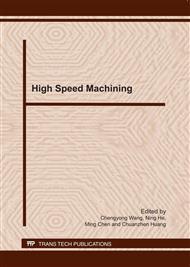p.208
p.212
p.216
p.220
p.224
p.230
p.236
p.241
p.246
Research on Dynamic Constitutive Relation of Materials Taking Account of Damage Evolution and Fracture Law for High Speed Cutting
Abstract:
The adiabatic shear, which may produce serrated chip, usually occurs for a large number of materials in high speed machining. Adiabatic shear band is an important damage model for metals under high-velocity deformation process. The damage evolution of micro-voids in adiabatic shear bands resulted in material fracture finally. Now the thermal softening effect, the strain rate harding effect and the strain harding effect have been discussed extensively in literature, but there is very little research on its damage effect. Based on the experiments of predecessors, this paper presents a new damage evolution equation that is dependent on strain, strain rate and is suitable for the description of voids damage evolution in adiabatic shear band. The corresponding rate-dependent constitutive relation taking account of damage evolution and temperature are proposed. The predicted results are in good agreement with the experiment datum.
Info:
Periodical:
Pages:
224-229
Citation:
Online since:
March 2011
Authors:
Price:
Сopyright:
© 2011 Trans Tech Publications Ltd. All Rights Reserved
Share:
Citation:


